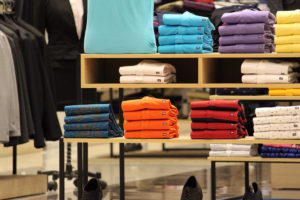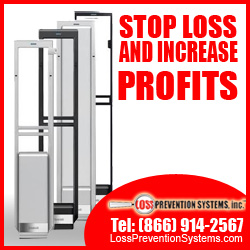 It’s 2019 and time to make some New Year’s resolutions! We all know how easy a resolution can be to make but they are hard to keep. We also know that it is just as easy to break a resolution but are there resolutions a store owner can make that would benefit the store AND benefit society? I think one resolution that would be mutually beneficial for both would be the implementation of environment-friendly policies and procedures. We are talking about sensible measures that would appeal to anyone on either side of the political spectrum. Right now there is a big push for the elimination of plastic shopping bags. There are also those opposed to going back to paper bags. What could the solution be? Try encouraging the use of recyclable, reusable shopping bags for your customers. You make those opposed to one-time use bags happy and you save money on the need to regularly purchase more shopping bags (which can be a rather pricey supply on your monthly expense report). To implement this type of change you would want to have reusable bags ready for your customers and you might even give them away for the first few weeks you start the program. After that, you might give customers a small discount to customers who bring their own bags, say 1% on every transaction.
It’s 2019 and time to make some New Year’s resolutions! We all know how easy a resolution can be to make but they are hard to keep. We also know that it is just as easy to break a resolution but are there resolutions a store owner can make that would benefit the store AND benefit society? I think one resolution that would be mutually beneficial for both would be the implementation of environment-friendly policies and procedures. We are talking about sensible measures that would appeal to anyone on either side of the political spectrum. Right now there is a big push for the elimination of plastic shopping bags. There are also those opposed to going back to paper bags. What could the solution be? Try encouraging the use of recyclable, reusable shopping bags for your customers. You make those opposed to one-time use bags happy and you save money on the need to regularly purchase more shopping bags (which can be a rather pricey supply on your monthly expense report). To implement this type of change you would want to have reusable bags ready for your customers and you might even give them away for the first few weeks you start the program. After that, you might give customers a small discount to customers who bring their own bags, say 1% on every transaction.
Problems that may arise by allowing recycled bags into the store. The first concern is the potential for increased shoplifting. Inviting customers to bring their bags into the store to bag groceries is going to make shoplifting that much easier. Thieves already walk by unattended cash registers to pick up plastic shopping bags as they enter the store. They fill them up, look like any other customer who has made a purchase at an in-store terminal and they leave. Most customers are honest but I would remind readers that one of the necessary ingredients for shoplifting is opportunity. Without opportunity, some people who may be tempted to steal for a thrill are kept in check. You provide opportunity by permitting reusable bags and some will take advantage of it. You also have to think, are the bags only allowed at the checkout stand? How do you keep shoppers from filling them up as a convenience rather than using a shopping cart? How do you monitor the shoppers for those who may be stealing and those who are simply picking up merchandise for purchase? It can lead to problems for store owners.
There is a way to allow the use of shopping bags and minimize the risk of increased shoplifting and that is the installation of an electronic article surveillance system (EAS). If you are going to resolve to help the environment you can still do it just by adding an EAS System in your store if you don’t already have one. You tag all of your merchandise with EAS tags or labels depending on what the merchandise is or how you strategize your theft prevention procedures. If a shopper has concealed merchandise in a bag they brought in and did not pay for it the alarm is going to be activated and your employees will respond to it.
Since we are on the topic of being environmentally responsible it is important that retailers know that many EAS tags are built out of recyclable materials. Hard tags can be used multiple times to tag and re-tag merchandise thereby saving on the need for constantly purchasing new tags and since they are recyclable they help the environment. It should also be noted a lot of Sensormatic systems help to reduce power consumption. When the systems are not in use (during non-working store hours) they go into a power saver mode. Stores save money and wasted energy. The use of EAS loss prevention equipment saves stores money by preventing theft and it allows stores the ability to appeal to their environmentally focused customers thus driving sales.
Another environment-friendly step you can make as a retailer is to look at recycling those cardboard boxes your merchandise is shipped in. A cardboard bale can bring in anywhere from $10 to $20 a ton. If this does not seem like a cost-effective move for your store you could try partnering with a neighboring store and combine efforts. It isn’t a lot of money but it does keep cardboard out of landfills and you can advertise that to your customers.
Resolutions may not be easy to keep but once you start down the road of using merchandise protection and you see the money you save in shortage and how easy it is to implement you won’t find it difficult to stay on track. In 2019, resolve to make some changes that will help the environment and make your store more profitable at the same time.
 Why would you do that especially when stopping shoplifters is so very simple? Loss Prevention Systems has the proven two step solution. Sensormatic EAS and a shoplifting prevention program that is easy and affordable. Our Sensormatic systems generally pay for themselves in approximately 5.5 months! Come on, you cannot afford to not fix the problem. Shoplifters are a threat from the moment you open until you move the last customer out your doors.
Why would you do that especially when stopping shoplifters is so very simple? Loss Prevention Systems has the proven two step solution. Sensormatic EAS and a shoplifting prevention program that is easy and affordable. Our Sensormatic systems generally pay for themselves in approximately 5.5 months! Come on, you cannot afford to not fix the problem. Shoplifters are a threat from the moment you open until you move the last customer out your doors. Do you want to know one of the fastest ways to make a Loss Prevention Manager cringe? Place high dollar merchandise within a few feet of your entrance/exit doors. Another great idea is to stack out a pallet of 32 inch LCD televisions for that Black Friday door buster with no protective devices on them because you know how fast they are going to go out the door (the L.P. Manager knows how fast too but from a different perspective). Frequently store managers want to put merchandise on display near the front of the store where customers are certain to see the items and entice them with an impulse buy. The downside to the strategy is that it creates a major opportunity for crooks to sneak merchandise out quickly without being noticed. They wait for a group of people to enter or leave, pick up the merchandise and blend in with the crowd then exit with the goods. I’ve seen it happen.
Do you want to know one of the fastest ways to make a Loss Prevention Manager cringe? Place high dollar merchandise within a few feet of your entrance/exit doors. Another great idea is to stack out a pallet of 32 inch LCD televisions for that Black Friday door buster with no protective devices on them because you know how fast they are going to go out the door (the L.P. Manager knows how fast too but from a different perspective). Frequently store managers want to put merchandise on display near the front of the store where customers are certain to see the items and entice them with an impulse buy. The downside to the strategy is that it creates a major opportunity for crooks to sneak merchandise out quickly without being noticed. They wait for a group of people to enter or leave, pick up the merchandise and blend in with the crowd then exit with the goods. I’ve seen it happen. It’s here! The holiday season and there is a spirit of goodwill that hopefully we all share towards each other. For retail owners and managers the joyful spirit is boosted when sales are good as customers are buying gifts and purchasing foods for baking and holiday meals. For the most part people seem to be a bit more patient towards each other (except maybe in a mall parking lot where drivers fight for the best parking places). It really is the most wonderful time of the year!
It’s here! The holiday season and there is a spirit of goodwill that hopefully we all share towards each other. For retail owners and managers the joyful spirit is boosted when sales are good as customers are buying gifts and purchasing foods for baking and holiday meals. For the most part people seem to be a bit more patient towards each other (except maybe in a mall parking lot where drivers fight for the best parking places). It really is the most wonderful time of the year! Loss Prevention is a wonderful career choice that can lead to other positions in retail. There are, however tips I wish I had known before I began the job that would have prepared me for the adventure I was about to embark on. I started out in a Loss Prevention Associate position after spending four years as a U.S. Air Force Law Enforcement Specialist and another 2 ½ years earning a Bachelor’s Degree.
Loss Prevention is a wonderful career choice that can lead to other positions in retail. There are, however tips I wish I had known before I began the job that would have prepared me for the adventure I was about to embark on. I started out in a Loss Prevention Associate position after spending four years as a U.S. Air Force Law Enforcement Specialist and another 2 ½ years earning a Bachelor’s Degree. Hiring employees is hard enough for retail owners without the pressures of hiring seasonal staff during the holidays as many stores are now doing. Under normal circumstances, managers and owners of retail businesses are stretched thin keeping a store operating efficiently. When turnover occurs more time is taken up as those managers are forced to focus their energies on filling holes in the weekly schedule. Job ads are posted and often paper applications are handed out as interested persons come in to respond to the ad or a “Help Wanted” sign posted in a window. Then there is the security risk that is involved in the hiring of new employees whether they are seasonal or to be a regular member of a team. A new hire carries an unknown quality and there is always the off chance that with even the best interview a criminal can slip between the cracks, the proverbial wolf in sheep’s clothing.
Hiring employees is hard enough for retail owners without the pressures of hiring seasonal staff during the holidays as many stores are now doing. Under normal circumstances, managers and owners of retail businesses are stretched thin keeping a store operating efficiently. When turnover occurs more time is taken up as those managers are forced to focus their energies on filling holes in the weekly schedule. Job ads are posted and often paper applications are handed out as interested persons come in to respond to the ad or a “Help Wanted” sign posted in a window. Then there is the security risk that is involved in the hiring of new employees whether they are seasonal or to be a regular member of a team. A new hire carries an unknown quality and there is always the off chance that with even the best interview a criminal can slip between the cracks, the proverbial wolf in sheep’s clothing. As of September 2018, the national unemployment rate is down to 3.7% according to ncls.org. As a retail store owner thinks about what this means for you in terms of trying to hire to fill job openings including seasonal hiring for the holidays. With an employment rate of 96.3% that leaves a sparse workforce as a hiring pool. I have read articles by those who think that with a dwindling number of people seeking work employers are going to have to forego pre-employment background checks. They seem to believe that the need to hire outweighs any baggage the job candidates bring with them.
As of September 2018, the national unemployment rate is down to 3.7% according to ncls.org. As a retail store owner thinks about what this means for you in terms of trying to hire to fill job openings including seasonal hiring for the holidays. With an employment rate of 96.3% that leaves a sparse workforce as a hiring pool. I have read articles by those who think that with a dwindling number of people seeking work employers are going to have to forego pre-employment background checks. They seem to believe that the need to hire outweighs any baggage the job candidates bring with them.  Traditionally Black Friday has been the kick-off of the holiday shopping season. Families spent Thanksgiving together dining, celebrating, catching up with each other and maybe even watching a football game on television. Early Friday following Thanksgiving store employees would start reporting to work preparing for early openings which often took place at 6:00 am. Retailers had advertised their Black Friday specials (Door Busters) and customers would start queuing up at the doors ready to find bargains. The shopping would then continue into Saturday and even Sunday patrons continued to look for bargains to stretch their dollars further. Then something began to happen, stores started competing for those dollars by opening their doors earlier and earlier. We ( I did this for quite a few years) would report to work and 3:00 am for a 5:00 am store opening. The next year we moved to 2:00 am arrival for a 4:00 am opening. Today stores are opening their doors on Thanksgiving Day. There are Pros and Cons to this shift that I think is worth exploring in a bit more depth.
Traditionally Black Friday has been the kick-off of the holiday shopping season. Families spent Thanksgiving together dining, celebrating, catching up with each other and maybe even watching a football game on television. Early Friday following Thanksgiving store employees would start reporting to work preparing for early openings which often took place at 6:00 am. Retailers had advertised their Black Friday specials (Door Busters) and customers would start queuing up at the doors ready to find bargains. The shopping would then continue into Saturday and even Sunday patrons continued to look for bargains to stretch their dollars further. Then something began to happen, stores started competing for those dollars by opening their doors earlier and earlier. We ( I did this for quite a few years) would report to work and 3:00 am for a 5:00 am store opening. The next year we moved to 2:00 am arrival for a 4:00 am opening. Today stores are opening their doors on Thanksgiving Day. There are Pros and Cons to this shift that I think is worth exploring in a bit more depth. Black Friday and the holiday shopping weekend has generally been the time of the year that most retailers are excited about. This is the time when shoppers are going to pull out their wallets and spend money. Deep discounts, doorbusters, even gift bags for the first customers, have been used to entice shoppers to visit stores early. It has been so successful as a marketing tool that stores have even advertised early Black Friday sales in JULY! Unfortunately, it seems that there has been a dark cloud overshadowing this weekend and it is more ominous each year. This cloud is one that can turn a Black Friday into a Bleak Friday if a store owner isn’t prepared for it.
Black Friday and the holiday shopping weekend has generally been the time of the year that most retailers are excited about. This is the time when shoppers are going to pull out their wallets and spend money. Deep discounts, doorbusters, even gift bags for the first customers, have been used to entice shoppers to visit stores early. It has been so successful as a marketing tool that stores have even advertised early Black Friday sales in JULY! Unfortunately, it seems that there has been a dark cloud overshadowing this weekend and it is more ominous each year. This cloud is one that can turn a Black Friday into a Bleak Friday if a store owner isn’t prepared for it. NO! not yet. Before we begin patting ourselves on the back you must remember that your Sensormatic System is only part of your shoplifting solution. Your Sensormatic System will protect your merchandise however, many shoplifters are determined and will try to steal anyway. The Sensormatic System itself is a deterrent. Its mere presence will dissuade many shoplifters.
NO! not yet. Before we begin patting ourselves on the back you must remember that your Sensormatic System is only part of your shoplifting solution. Your Sensormatic System will protect your merchandise however, many shoplifters are determined and will try to steal anyway. The Sensormatic System itself is a deterrent. Its mere presence will dissuade many shoplifters.
